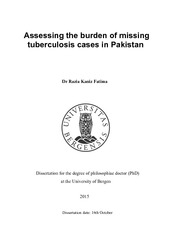Assessing the burden of missing tuberculosis cases in Pakistan
Doctoral thesis
Permanent lenke
https://hdl.handle.net/1956/10592Utgivelsesdato
2015-10-16Metadata
Vis full innførselSamlinger
Sammendrag
Approximately 3 million people get tuberculosis (TB) every year in the Eastern Mediterranean Region (EMRO) of World Health Organization (WHO) and a third does not get TB services. WHO urges countries to find, treat and cure the “missing” 1 million to accelerate progress towards zero TB deaths, infections, suffering and stigma.Pakistan has adopted WHO targets for TB control to achieve case detection rate of at least 70%. Pakistan reported a case detection rate of 58% for all types of TB, and ranks 3rd in ten countries that account for 74% (2.4 million) of the estimated missing cases globally in 2013. Private sector in Pakistan is huge and caters for an unknown but substantial number of TB patients. These health providers are not obliged by law to notify their TB cases, but some linked to National TB Control Program (NTP) are instructed to notify. This thesis assessed the burden of missing TB cases from national surveillance systems at various levels in health systems of Pakistan. To assess the extent of missing TB cases from national notifications, an inventory study was conducted in 12 randomly selected districts across Pakistan. The finding implied that the proportion of cases notified to NTP was only 32%, and our estimated incidence rates were significantly higher than 2011 WHO estimates. The same dataset was used to assess investigation and management practices of patients with presumptive TB by private providers. The results revealed that private providers mainly rely on public health sector for diagnosis and majority use both CXR and smear microscopy for diagnosis which revealed a great potential to engage them. A cohort study was done to assess proportion of lost patients with presumptive TB before diagnosis. This intervention significantly reduced proportion of those lost with presumptive TB .The study provides evidence that loss to follow up can be significantly improved by strategies such as encircling presumptive TB cases and simple comparison of registers. In another record review the loss of confirmed TB cases after diagnosis was estimated by comparing the laboratory registers with treatment registers. The loss was significantly higher in tertiary care hospitals compared to rural health centers. To identify TB cases missed by routine surveillance in hard to reach areas such as slums, chest camps were arranged and engaged private providers in order to increase TB case detection. This strategy can significantly increase the number of smearpositive TB case notifications.
Består av
Paper I: Fatima R, Harris RJ, Enarson DA, Hinderaker SG, Qadeer E, Ali K, Bassili A. Estimating tuberculosis burden and case detection in Pakistan. Int J Tuberc Lung Dis. 2014; 18(1):55-60. The article is not available in BORA due to publisher restrictions. The published version is available at: http://dx.doi.org/10.5588/ijtld.13.0198Paper II: Fatima R, Qadeer E, Enarson DA, Hinderaker SG, Harris RJ, Yaqoob A, Bassili A. Investigation of presumptive tuberculosis cases by private health providers: lessons learnt from a survey in Pakistan. Public Health Action. 2014; 4(2):110-112. The article is not available in BORA due to publisher restrictions. The published version is available at: http://dx.doi.org/10.5588/pha.13.0010
Paper III: Fatima R, Qadeer E, Hinderaker SG, YaqoobA, Enarson DA, Bassili A, ul Haq M, Javed B. Can the number of patients with presumptive tuberculosis lost in general health services in Pakistan be reduced? Int J Tuberc Lung Dis. 2015; 19(6):654-656. The article is not available in BORA due to publisher restrictions. The published version is available at: http://dx.doi.org/10.5588/ijtld.14.0751
Paper IV: Fatima R, Qadeer E, Enarson DA, Bissell K. Comprehensiveness of primary services in the care of infectious tuberculosis patients in Rawalpindi, Pakistan. Public Health Action. 2011, 1(1):13-15. The article is not available in BORA due to publisher restrictions. The published version is available at: http://dx.doi.org/10.5588/pha.11.0005
Paper V: Fatima R, Qadeer E, Enarson DA, Creswell J, Stevens R, Hinderaker SG, ul Haq M. Success of active tuberculosis case detection among high-risk groups in urban slums in Pakistan. Int J Tuberc Lung Dis. 2014; 18(9):1099-1104. The article is not available in BORA due to publisher restrictions. The published version is available at: http://dx.doi.org/10.5588/ijtld.14.0001
